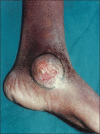Venous ulcers of the lower limb: Where do we stand?
- PMID: 23162226
- PMCID: PMC3495377
- DOI: 10.4103/0970-0358.101294
Venous ulcers of the lower limb: Where do we stand?
Abstract
Venous ulcers are the most common ulcers of the lower limb. It has a high morbidity and results in economic strain both at a personal and at a state level. Chronic venous hypertension either due to primary or secondary venous disease with perforator paucity, destruction or incompetence resulting in reflux is the underlying pathology, but inflammatory reactions mediated through leucocytes, platelet adhesion, formation of pericapillary fibrin cuff, growth factors and macromolecules trapped in tissue result in tissue hypoxia, cell death and ulceration. Duplex scan with colour flow is the most useful investigation for venous disease supplying information about patency, reflux, effects of proximal and distal compression, Valsalva maneuver and effects of muscle contraction. Most venous disease can be managed conservatively by leg elevation and compression bandaging. Drugs of proven benefit in venous disease are pentoxifylline and aspirin, but they work best in conjunction with compression therapy. Once ulceration is chronic or the patient does not respond to or cannot maintain conservative regime, surgical intervention treating the underlying venous hypertension and cover for the ulcer is necessary. The different modalities like sclerotherapy, ligation and stripping of superficial varicose veins, endoscopic subfascial perforator ligation, endovenous laser or radiofrequency ablation have similar long-term results, although short-term recovery is best with radiofrequency and foam sclerotherapy. For deep venous reflux, surgical modalities include repair of incompetent venous valves or transplant or transposition of a competent vein segment with normal valves to replace a post-thrombotic destroyed portion of the deep vein.
Keywords: Compression therapy; surgery on veins; venous hypertension; venous ulcers Indian Jou.
Conflict of interest statement
Figures



References
-
- Karl T, Modic PK, Voss EU. Indications and results of VAC therapy treatments in vascular surgery-state of the art in the treatment of chronic wounds [in German] Zentralbl Chir. 2004;129(suppl 1):574–9. - PubMed
-
- Collins R, Seraj S. Diagnosis and treatment of venous ulcers. Am Fam Physician. 2010;81:989–96. - PubMed
-
- Hareendran A, Bradbury A, Budd J, Geroulakos G, Hobbs R, Kenkre J, et al. Measuring the impact of venous leg ulcers on quality of life. J Wound Care. 2005;14:53–7. - PubMed
-
- González-Consuegra RV, Verdú J. Quality of life in people with venous leg ulcers: An integrative review. J Adv Nurs. 2011;67:926–44. - PubMed
LinkOut - more resources
Full Text Sources

